Introduction of Egyptian Arts
The magnificent realm of Ancient Egyptian Art stands as one of humanity’s most enduring artistic traditions, spanning over three millennia and continuing to captivate audiences worldwide. From the towering pyramids of Giza to the intricate hieroglyphs adorning temple walls, Ancient Egyptian Art represents an unparalleled fusion of aesthetic beauty and profound symbolic meaning.
Historical Timeline and Artistic Evolution of Ancient Egyptian Art
Pre-Dynastic Period (c. 6000-3150 BCE)
Early Pre-Dynastic (Badarian Period, c. 6000-3900 BCE)
The foundations of Egyptian Art emerged during this period with:
- Simple pottery featuring incised decorations and burnished surfaces
- Small figurines carved from ivory and clay
- Jewelry made from shells, beads, and semi-precious stones
- Earliest examples of painted pottery with geometric designs
Middle Pre-Dynastic (Naqada I, c. 3900-3650 BCE)
Art became more sophisticated with:
- Red pottery with white painted designs
- More complex geometric patterns and simple figurative art
- Development of ceremonial palettes for grinding cosmetics
- First examples of architectural tomb structures
Late Pre-Dynastic (Naqada II & III, c. 3650-3150 BCE)
Significant artistic developments occurred:
- Introduction of the distinctive Egyptian artistic style
- Creation of large ceremonial palettes like the Narmer Palette
- Development of hieroglyphic writing
- More complex tomb architecture
- Standardization of artistic conventions
- First examples of monumental architecture
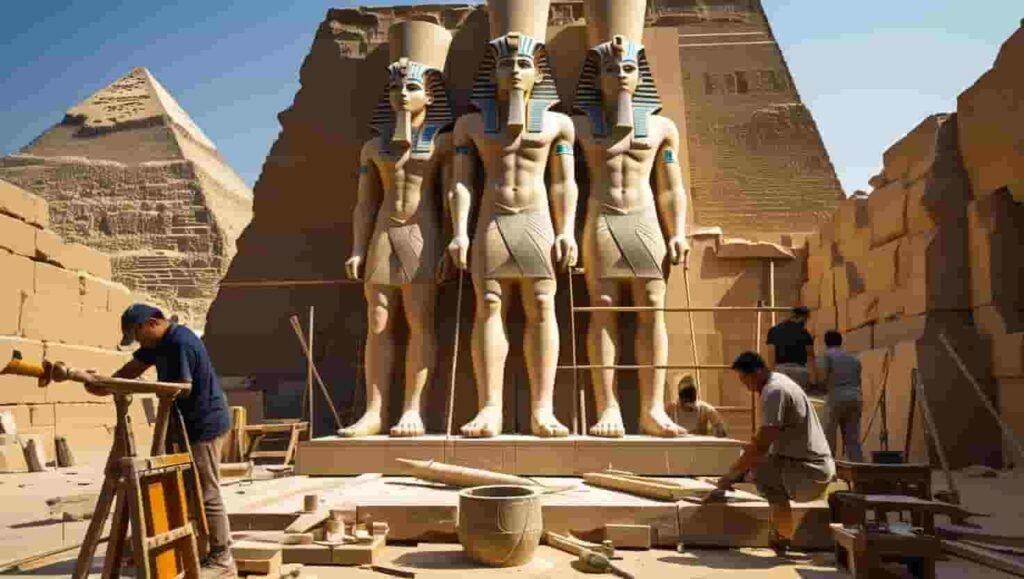
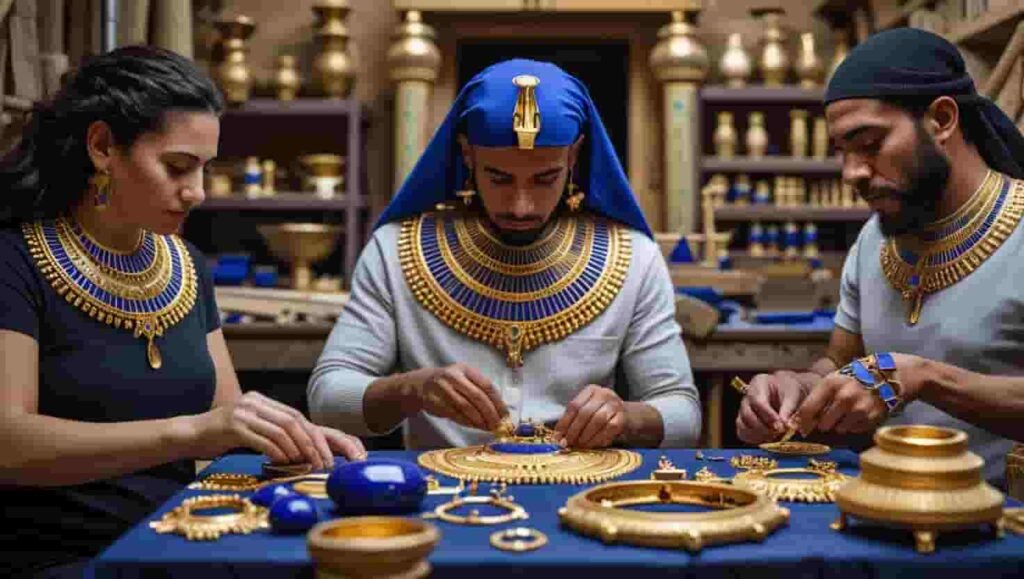
Key Artistic Characteristics
- Materials and Techniques:
- Use of local materials like Nile clay and limestone
- Development of firing techniques for pottery
- Innovation in stone carving methods
- Early experiments with copper working
- Symbolic Elements:
- Animal imagery representing early deities
- Geometric patterns with ritual significance
- Development of symbolic color usage
- Early hieroglyphic symbols
- Artistic Conventions:
- Beginning of the composite view in figure representation
- Development of ground lines in composition
- Establishment of hierarchical scaling
- Standardization of figure poses
Major Archaeological Sites
- Badari region: Early pottery and artifacts
- Naqada: Rich burial sites with artistic objects
- Hierakonpolis: Early temple and palace art
- Abydos: Ceremonial objects and early royal tombs
Significant Artifacts
- The Narmer Palette (c. 3150 BCE):
- Marks the transition to Dynastic period
- Shows early conventions of Egyptian Art
- Demonstrates hierarchical scaling
- Combines narrative scenes with symbolic elements
- Decorated Pottery:
- D-ware vessels with scenes of boats and figures
- C-ware with geometric patterns
- Black-topped red pottery
- Figurative Art:
- Small female figurines (fertility figures)
- Animal figurines
- Early royal statuary
Cultural Context
The artistic developments of this period reflect:
- Growing social complexity
- Development of religious beliefs
- Emergence of centralized authority
- Trade connections with neighboring regions
- Technological advancements
Legacy and Influence
The Pre-Dynastic period established:
- Basic principles of Egyptian artistic canon
- Technical foundations for later developments
- Symbolic vocabulary of Art of ancient Egypt
- Integration of art with religious and political power
- Groundwork for monumental architecture
This formative period laid the groundwork for the more familiar art of dynastic Egypt, establishing many of the conventions that would characterize Ancient Egyptian Art for the next three millennia. The evolution from simple geometric designs to complex symbolic representations marks the birth of one of humanity’s most influential artistic traditions.
Old Kingdom (c. 2686-2181 BCE)
Early Old Kingdom (Dynasties III-IV, c. 2686-2494 BCE)
Architecture
- Introduction of true pyramids, evolving from the Step Pyramid of Djoser
- Development of smooth-sided pyramids culminating in the Great Pyramid of Giza
- Establishment of the standard tomb complex layout including:
- Pyramid structure
- Mortuary temple
- Valley temple
- Causeway connecting temples
Sculpture
- Emergence of standardized royal portraiture
- Development of the seated pharaoh pose
- Introduction of the reserve head tradition
- Strict adherence to frontality and symmetry
- Use of cubic form in seated figures
Relief Carving
- Establishment of canonical proportions
- Development of register system for organizing scenes
- Focus on eternal themes rather than historical events
- Emergence of standard scene types for tomb decoration
Middle Old Kingdom (Dynasty V, c. 2494-2345 BCE)
Architecture
- Smaller pyramid complexes with more elaborate temples
- Introduction of sun temples at Abu Ghurob
- Expansion of nobles’ mastaba tombs
- Development of more complex internal chapel layouts
Sculpture
- Increased naturalism in royal portraiture
- Greater variety in non-royal statuary
- Development of family group statues
- Introduction of more dynamic poses in servant figures
Relief Work
- More detailed relief carving techniques
- Expansion of scene types in private tombs
- Introduction of more daily life scenes
- Enhanced modeling in low relief
Late Old Kingdom (Dynasty VI, c. 2345-2181 BCE)
Architecture
Sculpture
- Decline in pyramid size and quality
- Innovation in provincial tomb architecture
- Development of rock-cut tombs
- Experimentation with new temple layouts
- More individualized facial features
- Increased emotional expression in figures
- Greater variety in sculptural poses
- Development of provincial sculptural styles
Relief and Painting
- More narrative scenes in tomb decoration
- Integration of hieroglyphic texts with images
- Development of regional artistic styles
- Enhanced use of color and detail
Artistic Innovations and Developments
Materials and Techniques
- Mastery of hard stone carving
- Development of copper and stone tools
- Refinement of paint production methods
- Innovation in architectural engineering
Artistic Conventions
- Establishment of canonical proportions grid
- Development of composite perspective
- Standardization of royal insignia
- Creation of hierarchical scaling
Themes and Subjects
- Focus on eternal life and resurrection
- Emphasis on order and stability
- Integration of religious and political imagery
- Development of offering scene conventions
Cultural Context and Significance of Ancient Egyptian Art
Religious Function
- Art as a means of ensuring eternal life
- Visual representation of religious concepts
- Integration of art and ritual practice
- Development of funerary imagery
Political Role
- Art as expression of royal power
- Development of official style
- Use of art for propaganda purposes
- Standardization of royal imagery
Social Impact
- Art as marker of elite status
- Development of workshop traditions
- Training of specialized craftsmen
- Patronage systems and artistic production
Legacy and Influence
Artistic Traditions of Ancient Egyptian Art
- Establishment of Egyptian artistic canon
- Development of workshop practices
- Creation of enduring artistic conventions
- Influence on later Egyptian periods
Technical Achievements
Refinement of painting methods
Architectural engineering innovations
Development of sculptural techniques
Advances in relief carving
Middle Kingdom (c. 2055-1650 BCE)
Historical Context
The Middle Kingdom emerged from the reunification of Egypt under Mentuhotep II of the 11th Dynasty, marking a renaissance in Art of ancient Egypt after the turmoil of the First Intermediate Period. This era saw a return to centralized power and cultural refinement, leading to significant artistic developments.
Major Artistic Periods of Egyptian Art
Early Middle Kingdom (c. 2055-1985 BCE)
- Continuation of local artistic traditions from the First Intermediate Period
- Gradual establishment of new royal workshops
- Revival and reinterpretation of Old Kingdom artistic conventions
- Notable innovation in temple architecture, particularly at Deir el-Bahari
Classical Middle Kingdom (c. 1985-1750 BCE)
- Peak of artistic refinement under the 12th Dynasty
- Development of new sculptural styles emphasizing naturalism
- Flourishing of provincial art centers
- Sophisticated jewelry and metalwork production
Late Middle Kingdom (c. 1750-1650 BCE)
- Increasing regional variation in artistic styles
- Introduction of new artistic elements from Asian influences
- Continuation of royal patronage despite political decentralization
Artistic Innovations and Characteristics
Sculpture
- More naturalistic facial features compared to Old Kingdom works
- Introduction of “worried” expression in royal portraits
- Integration of individual characteristics while maintaining idealized forms
- Development of block statues as a new sculptural type
Relief Work
- Finer cutting and modeling than Old Kingdom predecessors
- Greater attention to detail in hieroglyphic carving
- Enhanced sense of depth in relief carving
- More complex compositional arrangements
Architecture
- Innovation in pyramid complexes with more elaborate mortuary temples
- Development of rock-cut tombs with sophisticated architectural elements
- Integration of columns with new capital designs
- Enhanced focus on temple architecture
Decorative Arts
- Advanced metalworking techniques
- Sophisticated jewelry incorporating semi-precious stones
- Development of new faience glazing techniques
- Enhanced quality in wooden coffin decoration
Technical Developments
Materials and Techniques
- Refined stone-working methods
- Advanced bronze casting capabilities
- Innovation in glazing technologies
- Development of new pigments and painting techniques
Tools and Processes
- Introduction of new stone-cutting tools
- Improved drilling techniques for hard stones
- Enhanced methods for architectural planning
- Advanced techniques for tomb preparation
Cultural Significance of Egyptian Art
Religious Context
- Enhanced focus on Osirian theology in funerary art
- Integration of local deity worship in provincial art
- Development of new religious iconography
- Enhanced role of personal piety in artistic expression
Social Impact
- Greater accessibility of art to provincial elites
- Increased production of private commemorative statuary
- Development of middle-class artistic patronage
- Enhanced role of art in expressing social status
Legacy and Influence
Impact on New Kingdom Art
- Establishment of artistic conventions that influenced later periods
- Development of techniques adopted in subsequent eras
- Creation of canonical forms for royal portraiture
- Influence on religious architectural design
Modern Significance
- Crucial period for understanding Egyptian artistic development
- Source of numerous masterpieces in modern museums
- Important influence on understanding Egyptian cultural evolution
- Key period for studying Egyptian technological advancement
Notable Examples
Royal Sculpture
- Portrait of Amenemhat III (Cairo Museum)
- Statues of Senwosret III (British Museum)
- Royal sphinxes from Tanis
- Portrait heads from Lisht
Temple Art
- Relief work at Deir el-Bahari
- Decorative programs at Karnak
- Provincial temple decoration
- Rock-cut shrine artwork
Provincial Art
- Tomb paintings from Beni Hasan
- Provincial statuary from Elephantine
- Regional relief work from Abydos
- Local workshop productions
Archaeological Context
Major Sites
- Lisht (12th Dynasty capital)
- Dahshur (royal pyramid complexes)
- Deir el-Bahari (Mentuhotep II complex)
- Beni Hasan (provincial tombs)
Recent Discoveries
Provincial site investigations
Continued excavations at Dahshur
New findings at Abydos
Ongoing work at Theban sites
New Kingdom (c. 1550-1070 BCE)
Historical Context
The New Kingdom represents ancient Egypt’s imperial phase, marked by unprecedented wealth, international contact, and artistic innovation. This period encompasses the 18th, 19th, and 20th dynasties, during which Egypt reached its height of power and cultural influence.
Major Artistic Developments of Egyptian Art
Early New Kingdom (18th Dynasty, c. 1550-1292 BCE)
- Royal Portraiture Revolution
- Departure from rigid Middle Kingdom conventions
- More naturalistic facial features
- Introduction of curved, sensuous lines
- Notable examples: Hatshepsut’s sculptures showing both feminine and masculine traits
- Architectural Innovations
- Rock-cut tombs in the Valley of the Kings
- Massive temple complexes like Karnak
- Integration of light and space in temple design
- Development of the hypostyle hall
Amarna Period (c. 1352-1336 BCE)
- Revolutionary Artistic Style
- Dramatic break from traditional Egyptian canon
- Exaggerated physical features in royal portraits
- Intimate domestic scenes of the royal family
- Emphasis on natural movement and expression
- Solar disk (Aten) depicted with reaching rays
- Technical Innovations
- Experimentation with sunken relief
- New approaches to perspective
- Enhanced detail in background elements
- Development of speed-carving techniques
Post-Amarna Period (19th-20th Dynasties, c. 1292-1070 BCE)
- Ramesside Period Art
- Return to traditional styles with new complexity
- Monumental scale in architecture and sculpture
- Enhanced military narrative scenes
- Refined relief carving techniques
Artistic Themes and Innovations
Materials and Techniques
- Expanded use of glass and faience
- Development of new pigments
- Advanced stone-cutting methods
- Innovations in metal-working
Iconography
- Greater emphasis on battle scenes
- Detailed foreign tribute scenes
- Complex religious imagery
- Increased representation of daily life
Stylistic Evolution
- More dynamic figure poses
- Enhanced spatial relationships
- Greater attention to anatomical detail
- Sophisticated modeling of forms
Cultural Exchange and Influence
- Incorporation of Minoan artistic elements
- Adoption of Syrian and Mesopotamian motifs
- Export of Egyptian artistic conventions
- Development of international artistic style
Legacy and Impact
- Influence on later Mediterranean art
- Establishment of monumental architectural principles
- Development of narrative art techniques
- Creation of enduring iconographic traditions
Major Surviving Works
- Temples of Karnak and Luxor
- Ramesseum and Abu Simbel
- Tomb paintings in the Valley of the Kings
- Tutankhamun’s funerary equipment
- Colossal statuary of Ramesses II
Technical Achievements
Mastery of various stone-working methods
Advanced understanding of proportion and scale
Sophisticated relief carving techniques
Development of complex architectural engineering
Fundamental Characteristics of Egyptian Art
Symbolic Color Usage
| Color | Symbolic Meaning | Common Applications |
|---|---|---|
| Gold | Divine and eternal | Royal artifacts, sun god Ra |
| Blue | Life, fertility | Sky deities, water scenes |
| Red | Life, power | Male skin tones, desert scenes |
| Green | Growth, resurrection | Osiris, vegetation |
| White | Purity, sacred | Ritual objects, priest garments |
| Black | Death, fertility | Underworld, fertile soil |
Artistic Principles and Conventions
- Hierarchical Scale
- Important figures depicted larger than less significant ones
- Pharaohs shown largest, followed by nobles, then commoners
- Divine beings represented at maximum scale
- Mathematical Precision
- Grid system used for proper proportions
- Strict canonical rules for human figure representation
- Architectural elements based on precise measurements
- Functionality and Purpose
- Art served religious and political purposes
- Every element had symbolic significance
- Works designed to last for eternity
Major Forms of Art of ancient Egypt
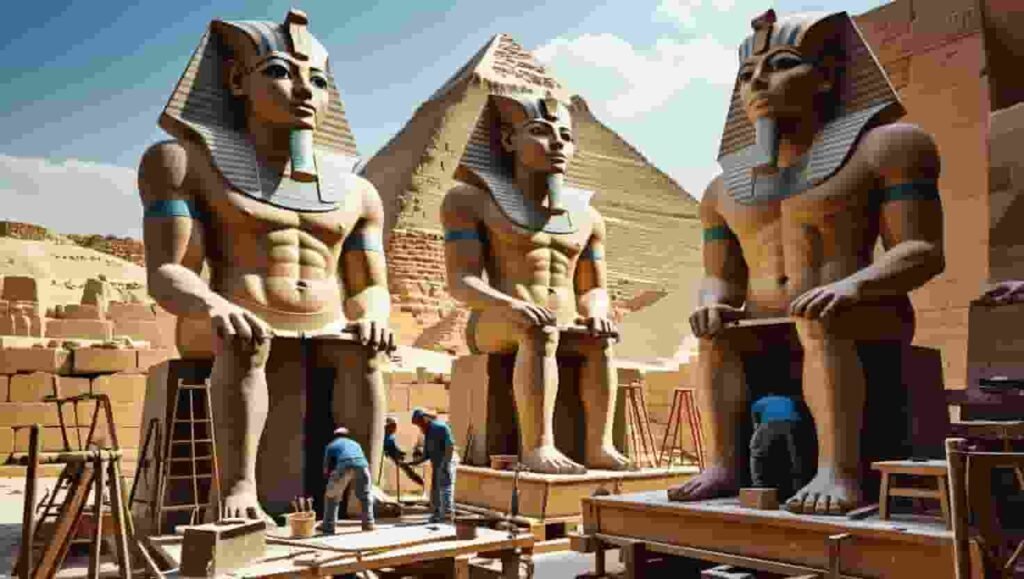
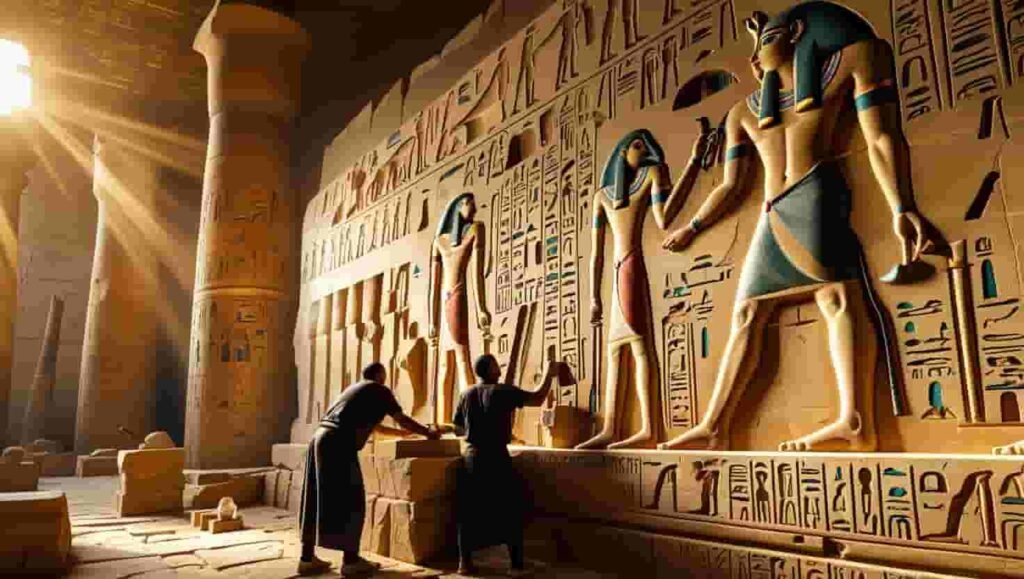
Architecture
The ancient Egyptians created some of history’s most impressive architectural achievements. Their buildings were designed not just for functionality but as expressions of divine order and royal power.
Key Architectural Elements:
- Massive stone construction
- Precise astronomical alignment
- Hieroglyphic decoration
- Symbolic architectural elements
- Integration with natural landscape
Sculpture
Egyptian sculpture ranged from colossal monuments to intimate figurines, each piece adhering to strict artistic conventions while displaying remarkable craftsmanship.
Notable Sculptural Types:
- Royal statuary
- Divine images
- Tomb sculptures
- Relief carvings
- Portrait busts
Painting and Relief
Wall paintings and reliefs served as both decoration and historical record, covering temple and tomb walls with scenes from daily life, religious rituals, and royal achievements.
Materials and Techniques
Common Materials:
- Limestone and sandstone for buildings and reliefs
- Granite and diorite for prestigious sculptures
- Gold and precious stones for royal artifacts
- Pigments from natural minerals
- Papyrus and wood for paintings
Technical Innovations:
- Development of copper and bronze tools
- Advanced stone-cutting techniques
- Sophisticated pigment preparation
- Innovation in glazing technologies
- Complex architectural engineering
Frequently Asked Questions
Q: How did Egyptian artists achieve such precise proportions?
Artists used a grid system and established mathematical ratios to maintain proper proportions. They also followed detailed canons of proportion that specified exact relationships between body parts.
Q: What materials were most commonly used in Egyptian art?
Limestone was the most common material due to its abundance and ease of carving. Other materials included granite, alabaster, gold, and various precious stones, each chosen for specific symbolic and practical purposes.
Q: How did Egyptian art influence other cultures?
Egyptian art significantly influenced Greek, Roman, and early Christian art. Its impact can be seen in architectural elements, sculptural techniques, and symbolic representations across various cultures.
Q: Why are many Egyptian artworks still so well-preserved?
The dry climate of Egypt, combined with the durability of materials used and the careful burial practices of the ancient Egyptians, contributed to exceptional preservation of many artworks.
Conclusion of Egyptian Art
Ancient Egyptian Art represents one of humanity’s greatest artistic achievements, combining technical mastery with profound symbolic meaning. Its influence continues to resonate through the centuries, inspiring artists and captivating viewers worldwide. The perfect balance of functionality, beauty, and symbolic significance makes Egyptian Arts unique in the history of human creativity.
The legacy of Ancient Egyptian Art extends far beyond its historical context, offering valuable insights into human creativity, technical innovation, and the power of artistic expression to convey cultural values and beliefs. As we continue to study and appreciate these ancient masterpieces, we gain deeper understanding of both our artistic heritage and the enduring human desire to create works of lasting beauty and significance.


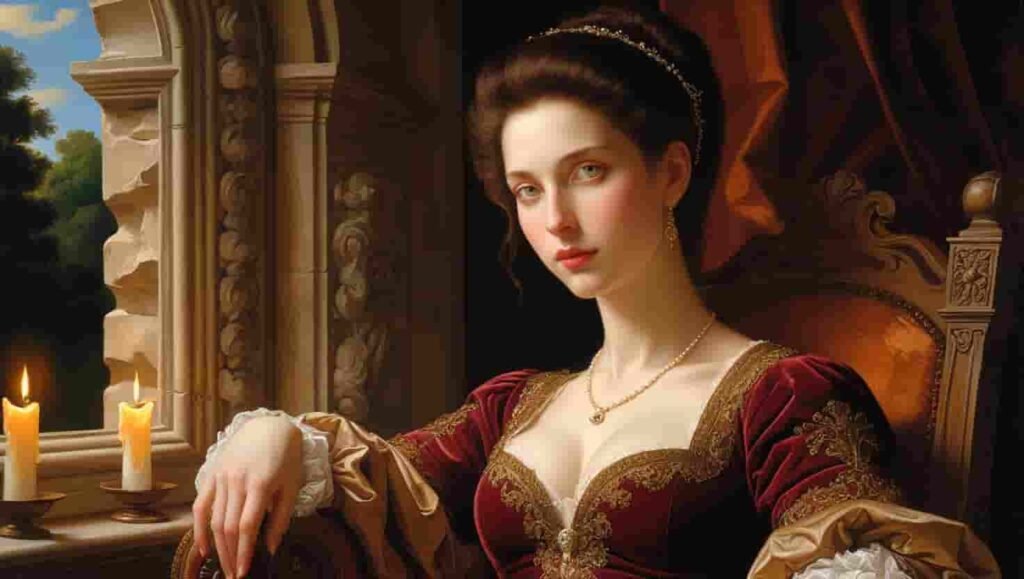

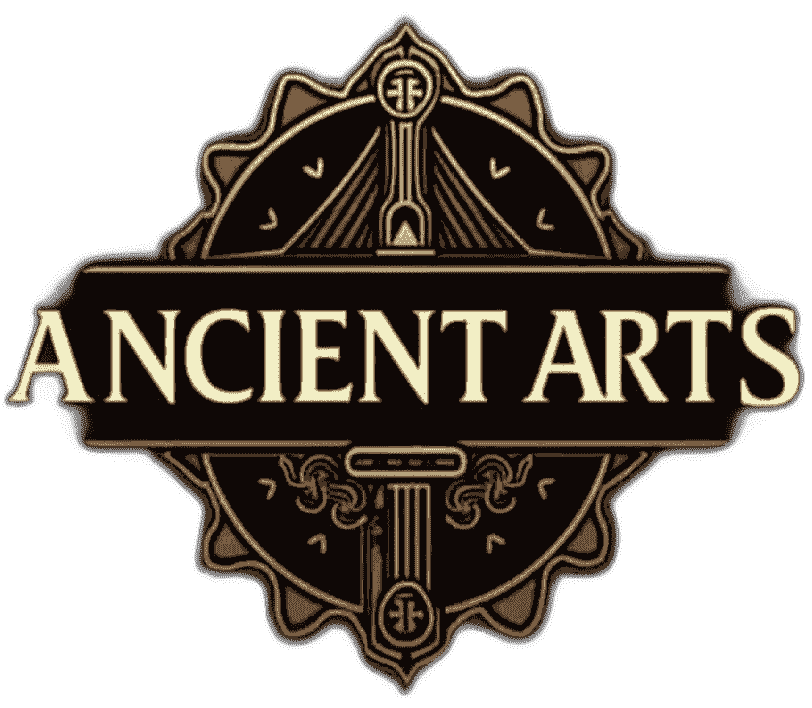
Pingback: Ka Statue - (Art History I – Prehistory to Middle Ages)
Pingback: Recto Art History